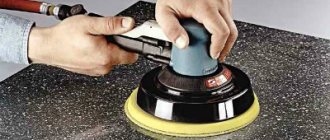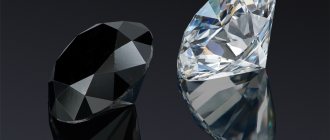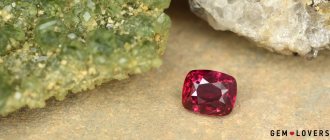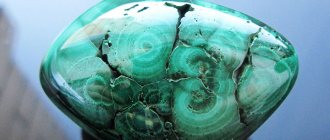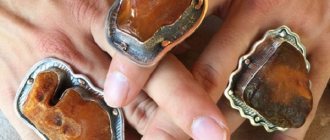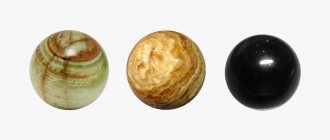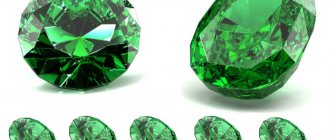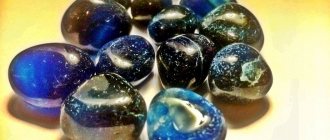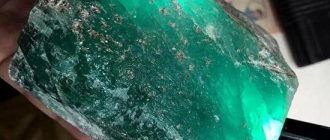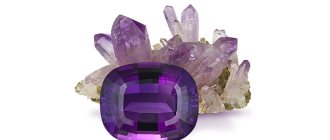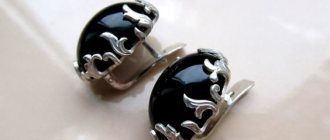The mesmerizing shine of moonstone attracts not only admirers of its beauty and magical properties, but also lovers of profit. They are increasingly trying to fake natural moonstone. But a fake will not help a person in love and will not cure ailments. Therefore, it is important to know how to distinguish a real moonstone from a fake.
The moonstone did not come to us from another planet and is not directly related to the satellite of our Earth. But if you take the mineral in your hands and turn it a little, you will see light coming from within. The heterogeneous color of the crystal with streaks, stars and a shine similar to the shine of a cat's eyes - all this is mesmerizing. And it’s not without reason that it is famous for its magical abilities, which are not found in artificial analogues. The second name of the mineral is adularia. A real moonstone will improve your health, improve relationships with your loved one and help you build a career. You can, of course, add fake adularia to your jewelry collection, but it won’t add joy. Therefore, let’s look in detail at how to distinguish natural moonstone from its bright counterparts, what is the main difference between them.
Why do they create fakes?
Moonstone is a beautiful gem with magical and healing properties. It is considered a natural indicator. He tells the owner whether his partners have true feelings for him, and whether the love of a loved one is cooling off. The stone fades. It seems that his qualities are changing. The gem attracts the eye and does not leave anyone indifferent. A real moonstone is becoming a desirable acquisition, why are they trying to fake it? There are several reasons:
- natural resources are being depleted;
- mining requires great physical exertion and complex equipment;
- processing conditions are specific and painstaking;
- high price for the breed.
A fake appearance can be presented instead of adularia. The person will hope for his help, turn to the abilities of the original, but this will not happen. What is most often used to replace a gemstone?
Medicinal properties
When the plague raged in medieval Europe, people wore opal rings as a protective amulet. Today, the medicinal properties of opal are used in the following areas:
- Psyche. The best for relaxation or meditation is Peruvian blue opal (ideally a ball). Removes excess emotions, relieves anxiety, and returns sound sleep. Noble opal will prevent fainting or relieve melancholy.
- Heart. The work will be regulated by pink opal. At the same time, it stimulates vital functions.
- Vision. Green opal will restore visual acuity if you massage it between the eyebrows (“third eye”) for five minutes a day.
- Gastrointestinal tract. Noble opal is suitable for relieving digestive problems or calming nerves.
Vital energy stimulator - fiery mineral. It should be used to treat weakened or lethargic people.
Synthetic material
Moonstone mined on the island of Sri Lanka is the most expensive. The original is almost colorless, but from the inside, when exposed to light, it becomes bluish-sparkling. There are millions of shades of adularia, they are difficult to replicate. For synthetic counterfeits, plastic and glass are used. They are tinted, trying to replicate the color of the lunar mineral. You can distinguish natural moonstone using several methods and knowledge about its properties:
- Reflection property. The product is placed on the floor at a right angle and the reflection is examined. The original reflects an angle of no more than 15ᵒ. The blue glow is lost. The fake gives a uniform shine when rotated in a circular motion.
- Thermal conductivity. Fake material tends to heat up quickly. Natural adularia does not heat up from the hands and retains its original temperature for a long time. Heating requires special equipment.
- Color brightness. You can recognize a mineral by the internal contents of the crystals. The natural mineral contains voids and air bubbles. This is not typical for artificial material; it is dense and solid, without flaws.
- Silky surface. The top layer of the processed stone feels like silk. It's pleasant and helps you calm down. It is this quality that is associated with its healing effect on the nervous system.
- Color change. It is recommended to distinguish a real gem using an experiment in which the product is placed in water. The stone becomes brighter, the colors are more saturated, and the shades stand out more clearly. Counterfeit products simply become cleaner when exposed to water.
Semi-precious crystals are counterfeited with such quality that it is difficult to distinguish differences from natural samples in appearance. You can buy jewelry for a jewelry collection and save money, but then you shouldn’t rely on the ability to heal and impart magic. Synthetic materials are successfully created in India, production is established and is in demand. But the manufacturer is not engaged in substituting naturalness, but offers the created moonstone openly.
How are moonstones used in magic?
Even in ancient Indian treatises on the properties of minerals, moonstone (jandarakand) is mentioned. For its extraordinary glow effect, it was credited with magical properties to reveal the future. Similar abilities to give mystical revelation to someone contemplating the depths of a crystal were known in Ancient Greece. Chaldean magicians used a shimmering shard by placing it in their mouth. The prophecies pronounced at this time were considered very truthful, especially during the full moon.
Adularia was also endowed with medicinal properties. It was believed that the moisture released by the crystal on a moonlit night could cure malignant fever. Medieval healers used the gem as a remedy for epilepsy.
Modern lithotherapists take into account that these minerals belong to the element of Water. Their ability to help in the treatment of urolithiasis is widely known. For nervous disorders and depression, one should contemplate the play of shades inside the crystal. This helps to drive away anxiety and achieve sound sleep without nightmares.
Silver necklace SL with cubic zirconia and moonstones (go to SUNLIGHT catalogue)
Who is the gem suitable for?
The mobile and receptive energy of the element of Water is not suitable for every character. It is possible to determine for whom a moonstone is suitable only by taking into account the person’s date of birth. Constant contact with him will be favorable only for signs belonging to the Water trine: Scorpio, Cancer, Pisces.
The main properties of the gem - dissolving negativity, peace, relaxation - will help to contain outbursts of anger and calm down during stressful conditions. He will be able to give even aggressive and energetic representatives of the Fire signs (Sagittarius, Leo, Aries) a little prudence. But for representatives of Air, constant contact with the mineral can result in apathy and reluctance to act. For those whose zodiac sign belongs to the element of Earth, not too frequent communication with the powerful energy of the gem can be beneficial by moderating excessive ambitions.
For magical and healing purposes, the gem is best worn only on the waxing Moon. At this time, and especially during the full moon, the energy of the stone grows. As soon as the luminary moves into the 3rd and 4th quarters, the strength of the mineral also decreases. At this time, it is better to use it to reduce negativity and relieve pain.
Similarities with belomorite
The lunar gem is distinguished by an internal glow called iridescence. Other minerals can also have this property. Among them there are cheap breeds. One such stone, similar to adularia, is belomorite. Distinctive features of minerals:
- different classes: adularia - orthoclasm, belomorite - oligoclasm;
- same hardness index;
- approximately similar level of internal structure density;
- same color palette;
- the color of belomorite is more saturated;
- the level of transparency varies.
Two similar minerals have different mystical abilities, they are unique, but there are no common abilities.
Adularia against peristeritis
See also
How to distinguish real Crocs from fakes
A cheap mineral called peristerite is also often passed off as moonstone. In terms of iridescence they are really similar.
But there are several characteristics by which you can recognize deception.
Peristerite is superior to moonstone in hardness, density, and light refraction.
The cleavage of the rocks is also different. But only a jewelry specialist can recognize deception. Moreover, for this you will need to use professional equipment.
Buying Tips
Natural stone will delight the owner and help throughout life. How to avoid becoming a deceived buyer. Here are some tips from the professionals:
- Buy in specialized stores. Trade jewelry stores always have their own brand. They strive to preserve and enhance their reputation and check the rating among similar trading offers. In such stores, each product has a quality certificate and information about the place of production. When purchasing jewelry at specialized outlets, you have the opportunity to return and make a complaint. The product will be replaced or checked for originality.
- Verified seller. Sellers value their customers' attitude towards them. They help you choose jewelry made from gems and explain how to care for products made from precious stones. It is not in their interests to deceive; they hope that the buyer will return to the store for a new decoration.
The Moon Gem has a quality that is unique to it: adularescence. At a certain angle, rays appear, they divide the stone into four parts. The property gives the effect of a “cat’s eye”, internal glow and magical attractiveness.
Moonstone Jewelry
Both its ability to help the owner and the effectiveness of the jewelry itself depend on how the moonstone is worn. Its characteristic as a discreet, faded-colored mineral does not allow combining such an insert with a gold frame. Moonstone in silver with blackening is very good: the dull shine of the metal does not suppress the material of the inserts. The rainbow tints of labradorite or the bluish glow of adularia are successfully emphasized by the calm color of the metal.
Jewelry made from a stone that shines like the moon is very rarely decorated with faceted inserts. Iridescence on the facets is not so noticeable, and asterism does not appear at all. Therefore, adularia, belomorite, and labradorite are often cut as cabochons. Combinations of moonstone with other gems are practically never found: a silver pendant or ring usually contains a single large insert. This is the only way to truly appreciate the beauty of the mineral and see the exquisite play of light in its depths.
Silver ring SL with alpanite, cubic zirconia and moonstones (go to the SUNLIGHT catalog)
Necklaces are also made from lunar minerals. Large adularia beads can be quite expensive, and a necklace 45-50 cm long reaches a price of several tens of thousands of rubles. Therefore, such jewelry is quite rare.
You also need to combine products made from these gems with clothes with taste. A shining droplet on a little black dress will look elegant. A very elegant combination can come from a strict classic suit with a pendant and earrings with shimmering stones.
A moonstone ring can also be worn by a man. Typically, such jewelry is purchased by people with a penchant for practicing magic. A silver ring with an adularia is considered to be an accessory for clairvoyants and psychics. In this case, what is considered is not the correspondence of the stone’s energy to the owner, but its significance as an amulet that causes visions. The decoration most often serves these purposes, since it has sufficient contact with its owner, and the silver of the frame further enhances the magical properties of the insert.
Appearance
So how can you tell a moonstone from a fake? First, let's find out what a natural mineral looks like. Externally, the crystal can be light gray with a pronounced bluish tint or colorless. Sometimes there are yellow tones. The crystal has a pearlescent sheen and is transparent.
If you look at it under a man-made light, the light inside it will begin to flicker. This is one of the correct ways to recognize whether a gemstone is real or synthetic.
A real sample can also be distinguished using a magnifying glass. The lamellar structure of a real mineral is always heterogeneous, with microcracks and possible inclusions of air bubbles. The reflection and glare inside the natural stone are transformed at a set angle of inclination, unlike its artificial counterpart.
Reasons for imitations
Everyone should know how to distinguish a moonstone from a fake. Adularia is often imitated due to:
- High cost of natural stones.
- Depletion of gem reserves.
- There is high demand for products made from this magical mineral.
- Large material and physical costs for stone extraction.
- Complex processing of adularia (requires professional skills and painstaking work).
The appearance of the counterfeit is almost no different from the original, but such a copy will not bring healing help.
Analogs
Since counterfeits are rarely found in nature, jewelers often use substitutes. Synthetic analogues are actively produced in India. And they sell well. But the sellers do not hide the fact that this is an imitation. Natural quartz is an inexpensive gemstone from the same mineral group.
All feldspar minerals have iris-like properties and the same structure. It is difficult to obtain results from simple tests.
Albite
The difference with the adularia is the color of the internal reflection. It is available in three colors: white, pink and blue. With blue, blue and violet iridescence. Other inconsistencies cannot be detected at home. It consists of physical and chemical indicators (difference in density and specific gravity).
